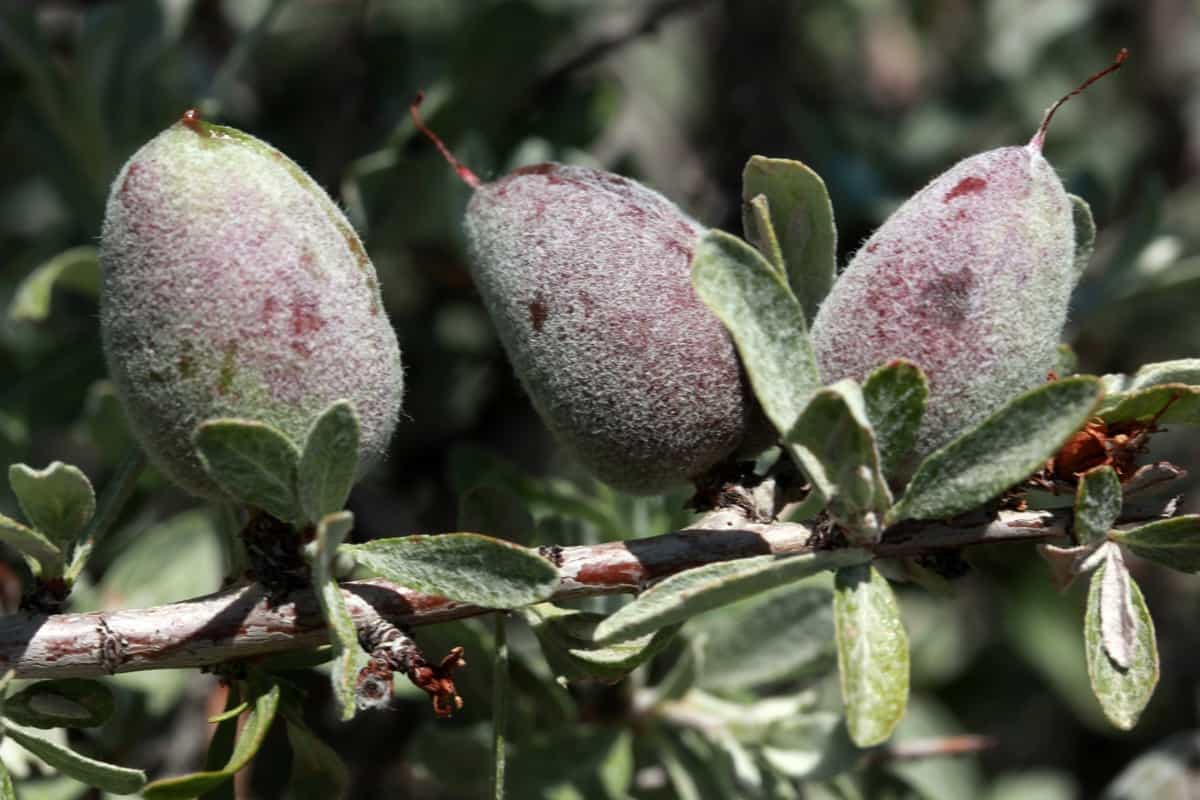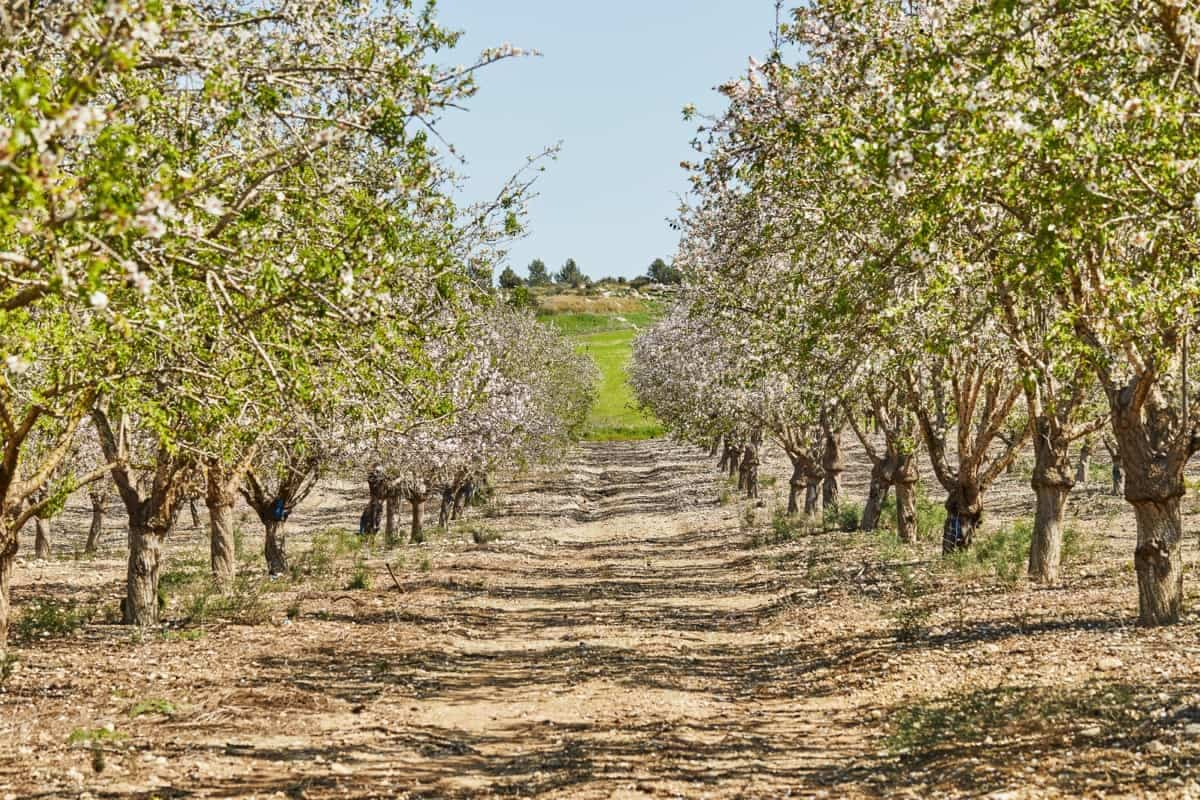Almond farming has gained significant attention due to its profitability and growing demand worldwide. This project report aims to comprehensively analyze the economics of cultivating almonds on a one-acre farm. By evaluating the cost factors, such as land preparation, planting, irrigation, fertilization, pest control, and harvesting, alongside the potential profits based on market prices and yields, this report offers valuable insights for individuals interested in almond farming. It aims to assist in making informed decisions and maximizing returns in this thriving agricultural sector.

What is Almond Farming?
Almond trees are deciduous and have a resilient period of dormancy. Typically reaching 3-4.5 meters (10-15 feet), these trees exhibit stunning beauty when adorned with fragrant, light pink to white flowers in the northern hemisphere between late January and early April. The flowers rely on insect pollinators to facilitate cross-pollination due to their self-incompatibility.
As the fruit matures, the peach-like drupe undergoes a transformative process where the leathery hull splits open, curls outward, and releases the hard-shelled seed within. While commonly referred to as nuts, almonds are technically seeds enclosed within a sturdy fruit casing.
Market and Demand for Almond Farming
The USDA projects a substantial almond production of 2.8 billion lbs for MY 2022/23, resulting in abundant supply. However, the increasing demand for almonds may need help due to high inflation and consumers spending more time away from home. The supply and demand situation has eased slightly due to the drought, leading to a 6% decrease in the 2022 harvest volume.
Despite this, almond inventories have accumulated, reaching 840 million pounds by the end of the 2021/22 marketing year. The global almond products market reached $9.4 billion in 2020 and grew at a CAGR of 12.8% from 2021 to 2028. This growth is fueled by health-conscious individuals’ rising preference for natural-based food products and the increasing demand for nutritionally superior offerings.
Best High-Yielding Variety for Almond Farming
- California Paper Shell: This variety has a light brown papery shell and flavorful kernels, but it is susceptible to bird damage.
- Shalimar: Featuring large-sized nuts with pointed ends, Shalimar has a light brown shell and a distinct crunchy flavor.
- Nonpareil: Early maturing with pale brown thin shells, this variety produces thick nuts with medium-sized kernels.
- Merced: This mid to late-season variety has flat, light brown nuts with a papery shell and a light-colored kernel.
- Pranyaj: With medium-sized almonds in a flat to bulging shape, Pranyaj has thin shells and a darker tone.
- Mukhdoom: This mid to late-season variety has plumpy kernels covered with a light-colored and semi-soft shell.
- IXL: IXL almonds have brownish nuts with a softshell of intermediate color and plumpy, medium-sized kernels.
- Drake: These almonds are small to medium-sized, ranging from light cream to light brown. The nuts are roundish and narrow at one end.
- Ne Plus Ultra: This variety has a flat, long kernel encased within an elongated shell. The almonds have slight wrinkles but are well-sealed.
- Waris: With the highest breadth of 20.42 mm, this medium-sized almond is bulged on one side and pointed at the apex.
Best Package and Practices for Almond Farming
Climatic Conditions for Almond Farming
- Suitable Climate: Almond farming thrives in colder regions where temperatures range between 7°C to 24°C. This temperature range is considered optimal for almond plant growth.
- Altitude: Almond plants can be grown from 750 to 3200 meters above sea level.
- Rainfall: Almond cultivation requires an average rainfall of 75 to 110 cm.
Soil Requirements for Almond Cultivation
- Soil Type: Flat, loamy, and deep fertile soil is well-suited for almond cultivation.
- Drainage: It is important to ensure proper drainage in the soil.
In case you missed it: 9 Causes of Dying Almond Trees and How to Fix Them?

Planting Techniques for Almonds
- Grafting: Almonds are typically grown using grafting techniques. Almond, peach, and plum seeds are commonly used as grafting stalks for almond plants.
- Transplanting: Almond seeds or one-year-old plants with healthy, leafless roots are used for transplanting. Before transplanting, pits measuring 111 meters should be prepared, and cow dung and earthworm manure should be added to the pits. The planting is usually done in November and December, with a spacing of around 6 meters between plants and 7 meters between rows.
Pollination and Beekeeping
Bees for Pollination: Keeping 5-7 cans of bees per hectare of land is recommended to ensure good pollination.
Irrigation and Water Requirements
- Winter Irrigation: In the winter season, irrigation should be carried out at 20-30 days intervals.
- Summer Irrigation: During summers regular irrigation is required every ten days, especially for fruit-bearing plants, to prevent unripe fruit drop.
Mulching and Weed Control
- Mulching: Using straw, leaves, or other organic materials around almond trees helps reduce weed growth and maintain moisture in the soil.
- Weeding: Regular weeding is essential for good yields. The first weeding should be done within 10-15 days, followed by regular maintenance.
Harvesting Almond Fruits
- Fruiting Time: Almond trees typically bear fruits in the third year after transplantation, with higher yields observed after 6-7 years.
- Harvest Timing: Almonds are ready for harvest approximately eight months after flowering when the almond pods’ peel turns from green to yellow. Harvesting is usually done using poles.
Drying and Storage
Drying: After harvesting, almond nuts should be sun-dried or dried using forced hot air until the moisture content reaches 5 to 7% to prevent fungal infections. Proper drying and storage practices help maintain the quality and longevity of the harvested almonds.
1-Acre Almond Farming Cost and Profit
The components included in the cost of cultivation for Almond farming typically consist of seeds, land preparation, fertilizers, organic manure/compost, irrigation, weed management, pest and disease control, harvesting and threshing, post-harvest management, and miscellaneous expenses.
| Cost Components | Estimated Range (USD) |
| Land preparation | $500 – $700 |
| Almond saplings | $100 – $200 |
| Irrigation system | $500 – $800 |
| Fertilizers and nutrients | $500 – $700 |
| Pesticides and insecticides | $300 – $400 |
| Labor and farm management | $800 – $1000 |
| Equipment and machinery | $200 – $300 |
| Miscellaneous expenses | $300 – $500 |
| Total Cost of Cultivation | $3900 – $4100 |
Total Returns and Net from 1Acre Almond Farming
- Yield per Acre: Given the 1 to 1.2 tonnes yield range per acre, let us take the average yield of 1.1 tonnes (1100 kilograms).
- Price per Kilogram: 1 kilogram of almonds is stated as $6.02.
- Total Revenue = Yield per Acre * Price per Kilogram Total Revenue = 1100 kg * $6.02/kg
- Total Cost of Cultivation: The cost of cultivation range provided is $3900 to $4100.
- Net Profit = Total Revenue – Total Cost of Cultivation
- Total Revenue = 1100 kg * $6.02/kg = $6622
- Considering the cost range, the total cost of cultivation is $4000.
- Net Profit = $6622 – $4000 = $2622
Therefore, the estimated net Profit from 1 acre of almond farming, considering the given yield, price, and cost range, is approximately $2622.
In case you missed it: How to Start Almonds Farming in California: A Step-By-Step Production Guide for Planting to Harvest

Challenges and Risks in Almond Farming
Almond farming presents various challenges and risks. Water availability, pests, diseases, and extreme weather conditions can impact crop health and yield. Rising production costs, market volatility, and price fluctuations also pose risks to profitability. Additionally, changing environmental regulations and labor shortages further add to the complexities of almond farming, requiring farmers to implement sustainable practices and effective risk management strategies.
Conclusion
Almond farming on a one-acre farm has the potential to be a profitable venture. Despite challenges and risks, such as water availability, pests, and market fluctuations, the increasing global demand for almonds presents opportunities. By carefully managing costs, implementing sustainable practices, and staying informed about market trends, farmers can maximize their profits and contribute to the thriving almond industry.
- Feed Your Flock for Less: Top 10 Tips to Save on Chicken Feed
- Ultimate Guide to Ossabaw Island Hog: Breeding, Raising, Diet, and Care
- Hatching Answers: The Top 10 Reasons Your Chickens Aren’t Laying Eggs
- Eggs and Economics: Breaking Down the Cost of Raising Backyard Chickens
- Defend Your Greens: Proven Methods to Keep Iguanas Out of Your Garden
- Ultimate Guide to Cinnamon Queen Chicken: A Comprehensive Guide for Beginners
- Ultimate Guide to California Tan Chicken: Breeding, Raising, Diet, Egg-Production and Care
- Ultimate Guide to Marsh Daisy Chicken: Breeding, Raising, Diet, and Care
- 10 Types of Chicken Farming Businesses You Can Start for Profits